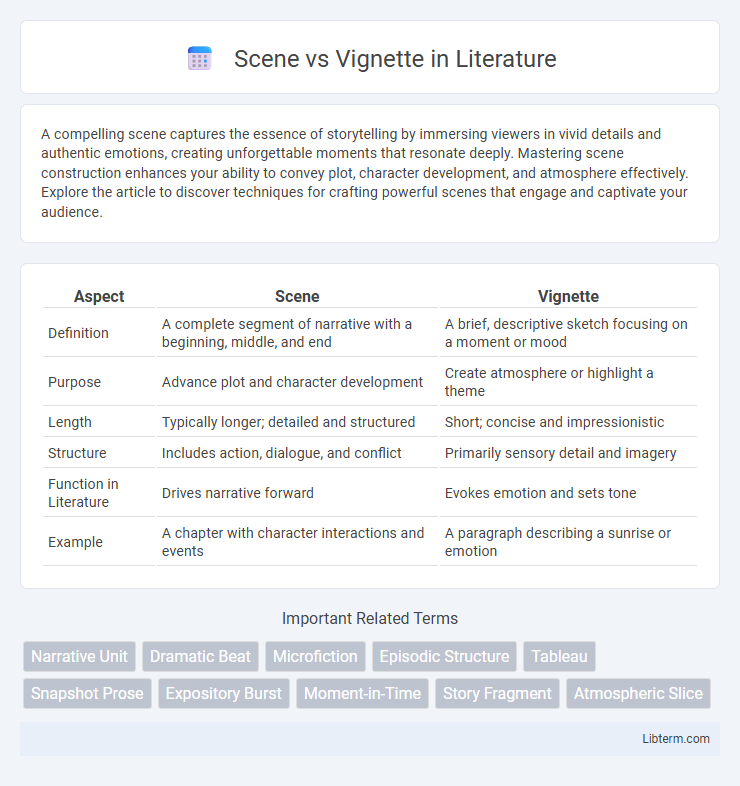A compelling scene captures the essence of storytelling by immersing viewers in vivid details and authentic emotions, creating unforgettable moments that resonate deeply. Mastering scene construction enhances your ability to convey plot, character development, and atmosphere effectively. Explore the article to discover techniques for crafting powerful scenes that engage and captivate your audience.
Table of Comparison
| Aspect | Scene | Vignette |
|---|---|---|
| Definition | A complete segment of narrative with a beginning, middle, and end | A brief, descriptive sketch focusing on a moment or mood |
| Purpose | Advance plot and character development | Create atmosphere or highlight a theme |
| Length | Typically longer; detailed and structured | Short; concise and impressionistic |
| Structure | Includes action, dialogue, and conflict | Primarily sensory detail and imagery |
| Function in Literature | Drives narrative forward | Evokes emotion and sets tone |
| Example | A chapter with character interactions and events | A paragraph describing a sunrise or emotion |
Understanding Scenes and Vignettes
Scenes create a structured narrative segment with a clear beginning, middle, and end, often involving dynamic character interactions and advancing the plot. Vignettes are brief, descriptive snapshots that emphasize mood, setting, or character insights without progressing the main storyline. Understanding these differences aids writers in balancing detailed context with plot-driven storytelling to enhance reader engagement.
Defining a Scene: Key Characteristics
A scene is a fundamental unit of storytelling defined by a specific setting, time, and continuous action that advances the plot or develops characters. It typically contains clear conflict or interaction, driving the narrative forward through dialogue, events, or emotional shifts. Scenes are structured to establish a beginning, middle, and end, creating a coherent and immersive experience for the audience.
What is a Vignette?
A vignette is a brief, focused narrative fragment that captures a single moment, mood, or detail, often without a clear beginning, middle, or end. Unlike a full scene, vignettes emphasize atmosphere and character insight rather than plot progression or dialogue. Writers use vignettes to evoke emotions and highlight specific themes through vivid imagery and concise description.
Structure and Purpose of Scenes
Scenes serve as fundamental building blocks in storytelling, structured to present a specific event or interaction with a clear beginning, middle, and end that advances the plot or develops characters. Each scene typically contains a goal, conflict, and outcome, designed to create emotional engagement and drive the narrative forward. In contrast, vignettes are brief, impressionistic moments that emphasize mood or theme without a structured narrative arc or direct plot progression.
Structure and Purpose of Vignettes
Vignettes are short, focused narrative pieces that capture a specific moment or detail, emphasizing mood and impression rather than a full plot progression typical of scenes. Unlike scenes that follow a clear beginning, middle, and end to advance the storyline, vignettes often lack a traditional narrative arc and instead prioritize atmosphere, character insight, or thematic resonance. The structure of vignettes is flexible, allowing writers to convey subtleties and emotional nuances that enrich the overall narrative without the constraints of detailed exposition or extensive action.
Scene vs. Vignette: Core Differences
A scene is a complete unit of story action with a clear beginning, middle, and end, often depicting significant events or turning points. A vignette is a brief, descriptive snapshot that captures a moment, mood, or character detail without a structured narrative arc. Scenes drive plot progression, while vignettes enrich atmosphere and provide deeper emotional or thematic insight.
When to Use a Scene in Writing
Use a scene in writing when you need to convey real-time action, dialogue, or immersive interaction that advances the plot or develops characters. Scenes are essential for creating dynamic moments that show rather than tell, allowing readers to experience events alongside the characters. Employ scenes during key turning points, conflicts, or emotional reveals to maintain narrative momentum and reader engagement.
When to Choose a Vignette
A vignette is ideal when emphasizing a brief, intense moment or detail without the need for a full scene setup, allowing readers to experience emotional or sensory impressions succinctly. Choose a vignette to highlight specific character insights, atmospheric elements, or thematic nuances that benefit from brevity and focused description. This technique effectively enhances pacing by avoiding scene-length exposition while deepening reader connection through concentrated narrative snapshots.
Examples of Scenes and Vignettes
Scenes in literature often depict a continuous sequence of events, such as a heated argument between characters or a suspenseful escape, creating a dynamic and immersive experience. Vignettes, in contrast, capture brief, evocative moments like a child's first snowfall or an elderly person recalling a poignant memory, providing rich sensory detail without advancing the plot. These distinct narrative tools serve different purposes: scenes drive the story forward, while vignettes illuminate mood and character depth.
Tips for Writing Effective Scenes and Vignettes
Effective scenes immerse readers through detailed settings, dialogue, and action that advance plot and character development, creating momentum in the narrative. Vignettes rely on vivid imagery and sensory details to evoke mood or snapshot moments without necessity for plot progression. Writers should balance pacing by using scenes for dynamic storytelling and vignettes for emotional depth or thematic resonance.
Scene Infographic

 libterm.com
libterm.com